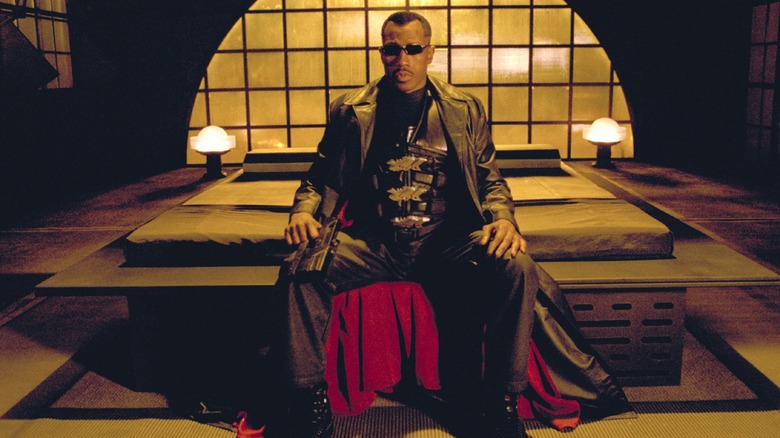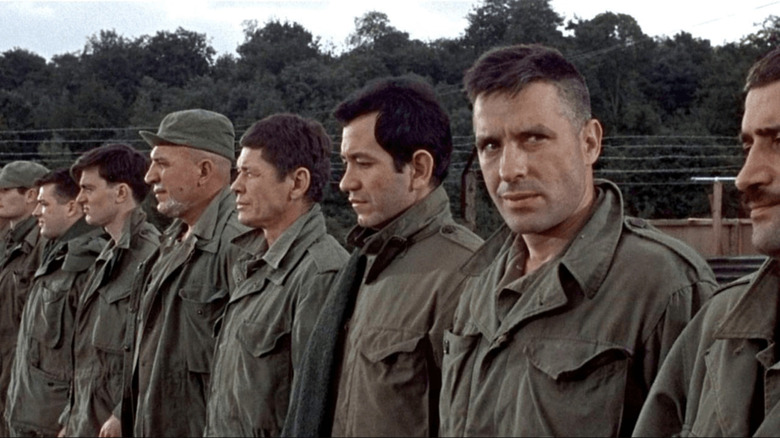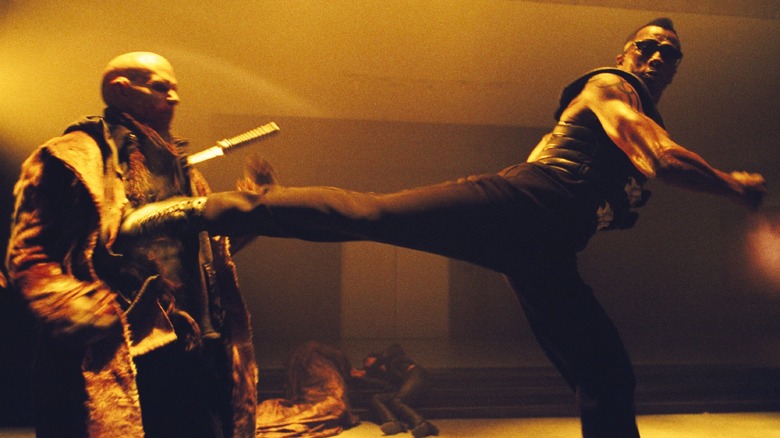Blade II Found Its Inspiration In An Oscar-Winning Classic
In 1998, when Steven Norrington's "Blade" was released in theaters, it caused only the smallest stir in the consciousnesses of comic book fans. Based on a character from Marvel comics, Blade (Wesley Snipes) was a half-vampire, shades-and-sword-sporting badass who stalked into the night to kill vampires. In the world of "Blade," vampires were the head of their own secret, elite, class-based underground society divided by those who were born vampires (vampires can have babies in the regular way, it seems), and those who had been bitten and converted. Blade wages war with a particularly nasty vampire named Deacon Frost (Stephen Dorff) who seeks a magical MacGuffin that would transform him into a super-vampire.
"Blade" is a bit silly, but its techno soundtrack, cyber-influenced aesthetic, and too-cool-for-school hero made it stand out. Young fans of Marvel comics were astonished that such a good movie could be made out of such an obscure character.
In 2002, "Blade II" was released, this time directed by Guillermo del Toro. "Blade II" was penned by David S. Goyer, who also wrote the first film, and who would go on to write major blockbusters like Christopher Nolan's "Batman Begins," "Terminator: Dark Fate," and "Man of Steel." For "Blade II," both del Toro and Goyer wanted to up the previous film's "monster factor" by presenting the eponymous vampire hunter with a species of creatures called Reapers, which could unhinge their jaws and feed on the blood of both humans and vampires. They had also stronger rib cages, making them less susceptible to being staked through the heart.
Goyer also wanted to change Blade's solitary nature by teaming him up with a cadre of vampires to fight the Reapers, an elite squad of bloodsucking mercenaries called The Bloodpack who had previously been training to kill Blade, the man who killed so many of their friends. The characters were eager to kill one another, but the Reapers forced them into an uneasy alliance. If the setup sounds familiar, it's because you've seen Robert Aldrich's 1967 film "The Dirty Dozen."
The Dirty Dozen
"The Dirty Dozen" is perhaps one of the manliest films ever made. In Robert Aldrich's film, Lee Marvin plays a WWII army major who must assemble a crack squad of soldiers to take on what is essentially a suicide mission: Infiltrate a remote mansion populated by multiple members of the Nazi high command and murder them all. In so doing, they will curtail the Nazi chain of command and allow Allied forces to more easily invade. The squad Marvin assembles consists of 12 men who have each been sentenced to death for crimes of violence. Marvin will train them, get them to follow orders, focus their free-floating rage, and save the day. The dozen included John Cassavetes, Charles Bronson, Telly Savalas, Jim Brown, Donald Sutherland, and other intense character actors. It was nominated for four Academy Awards.
The plot of "The Dirty Dozen" — assemble a ragtag team of misfits to take part in a single mission — has been employed by films such as "The Wild Bunch," "The Longest Yard" (also directed by Aldrich), "Inglourious Basterds," "The Expendables," and even superhero flicks like "The Avengers" and "Suicide Squad." And, of course, "Blade II." In Sci-Fi Wire, Goyer said of the sequel:
It's basically 'The Dirty Dozen.' A threat emerges that could potentially wipe out both the vampire and the human races. Blade is put in a situation where he's forced to team up with the vampires because it's for the good of both races.
The violence
Apart from the basic setup, another thing that "The Dirty Dozen" and "Blade II" have in common is their pervasive violence. "Dirty Dozen" was widely criticized for its outsize cruelty, seemingly taking just a little bit too much delight in murdering its characters. At the time, Roger Ebert was frustrated that so much sex had been censored in movies, but the burning corpses in "The Dirty Dozen" were left on display.
"Blade II," meanwhile, came out in 2002, a time when violence in movies was being reevaluated in the wake of 9/11. Would action violence have the same impact on audiences now that so much real-world violence and death had just been seen on the news? David S. Goyer acknowledged the bloody monster violence of "Blade II," but also admitted that the filmmakers were given something of a "pass" by the studios because of its fantasy elements:
There wasn't that much pressure [to tone down the violence]. It's such a stylized world that I don't think anyone can misconstrue it for reality by any stretch of the imagination. It really wasn't a consideration. New Line felt that nobody would point a finger at this movie. It's [based on] a comic book. If it was a movie that was firmly set in the real world, it would have been more of an issue.
Incidentally, Roger Ebert would give "Blade II" three-and-a-half stars, calling it "a really rather brilliant vomitorium of viscera, a comic book with dreams of becoming a textbook for mad surgeons." So, yes, "Blade II" was violence, and Guillermo del Toro's love of blood and monsters shines through, leaving something that is more fun than disturbing, more gleefully violent than hard-edged. At the end of the day, "Blade II" is more fun than "The Dirty Dozen."


